The UK has a structured waste code system, known as the European Waste Catalogue (EWC); Introduced in the UK in 2001 following the adoption of EU Decision 2000/532/EC, it provides a unified language for categorising waste types across Europe.
By 2005, the EWC was fully embedded in UK law under the List of Wastes (England) Regulations, giving us the six-digit codes we still use today to classify everything from textiles (20 01 11) to halogenated still bottoms and reaction residues (07 02 07*). Despite Brexit, the UK continues to use these codes, now just referred to as LoW (List of Waste) codes.
A Brief Look at Our Own Waste Code Roots
We have the language, but now, we need the technology. That’s where South Korea’s Allbaro system comes in.
If waste had a passport, South Korea’s Allbaro system would be its immigration control, customs, and CCTV all rolled into one. Since 2001, Allbaro has been the envy of the global waste community offering a gold standard in digital waste tracking. As the UK gears up to launch its own mandatory digital waste tracking system in 2026, we would do well to take notes from a country that’s been doing it right for over two decades.
Launched by the Korea Environment Corporation (KECO), Allbaro (literally meaning “correctly” in Korean) is South Korea’s cradle-to-grave tracking system for industrial waste; fully digitised, mandatory, and uncompromising in its detail - every time waste is produced, moved, or treated, it’s logged into a central platform in real time.
How It Works - who is obligated:-
• Waste Generators: Businesses that produce industrial waste.
• Transporters: Licensed carriers tracked via GPS.
• Treatment Facilities: Sites that receive, process, and dispose of waste, digitally confirming receipt and final treatment.
Key features include:
• Real-time digital manifests for every waste movement.
• Waste classification codes, similar in spirit to our EWC codes.
• Vehicle tracking, RFID, and CCTV integration for high-risk transfers.
• A regulatory dashboard allowing authorities to catch illegal movements before the waste even arrives.
Over 17 million waste transfers are recorded annually, Illegal dumping has plummeted since the system launched.
Transparency is built-in, businesses and regulators see the same data - Allbaro has been cited as best practice by the OECD and World Bank.
The UK's Digital Waste Tracking Plans
The UK’s Environment Act mandates the rollout of a mandatory digital waste tracking service by 2026 and aims to unify fragmented systems, improve enforcement, and help shift toward a more circular economy.
So far, the plans are promising: EWC (LoW) code integration, mandatory reporting, and a digital platform for all waste movements. But being honest, promise is the easy bit, delivery is where things usually get sticky.
Why the UK Should Look to Allbaro?
• Proof it Works: Allbaro’s long track record shows that digital waste tracking isn’t some utopian fantasy. It’s operational, enforceable, and effective.
• Built-In Compliance: By embedding checks at every stage, Allbaro reduces the need for costly enforcement actions after the fact.
• Smart Tech: The UK mustn’t be shy about integrating GPS, RFID, and real-time alerts. These aren't gimmicks, they’re game-changers. Systems like C-Trace have proved this. • Data is Power: Two decades of Allbaro data informs South Korea’s environmental policies. The UK must see data not as a burden, but as fuel for smarter decisions.
As we inch toward 2026, the UK has a golden opportunity to leapfrog years of inefficiency by learning from South Korea’s Allbaro. It’s not about copying homework, it’s about realising that good ideas travel well, even when waste doesn’t, so let’s stop managing waste like it’s still 1995, let’s manage it like it’s Allbaro. Digital waste tracking - link - Section 58 - link - Allbaro - link - more like this - (waste) - link - more like this (South Korea) - link 


















